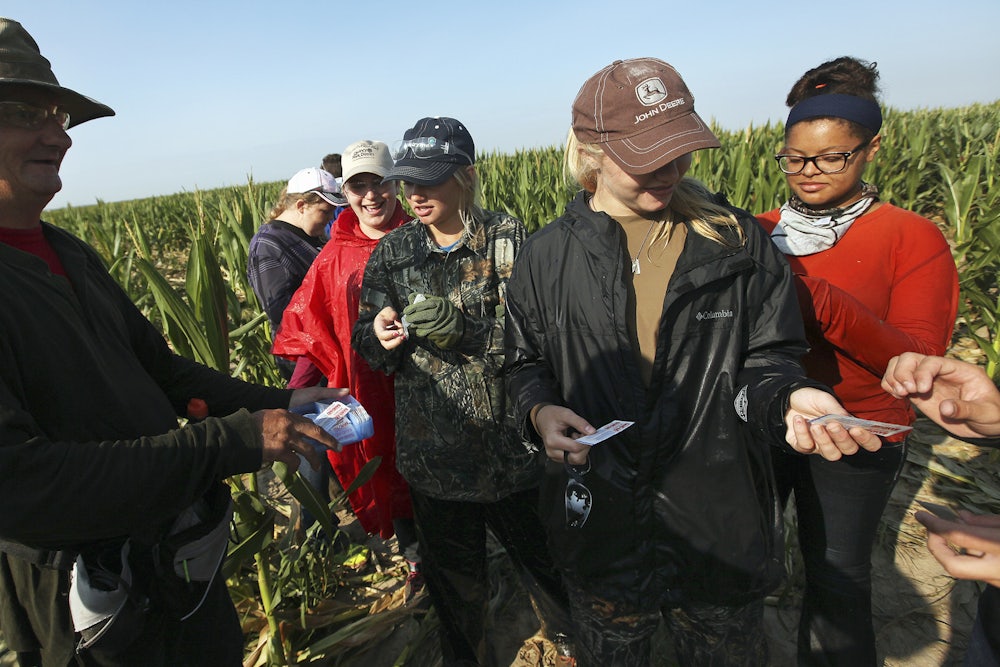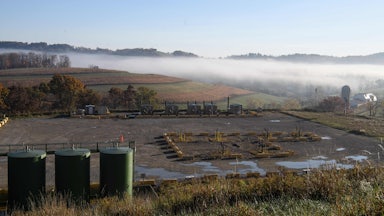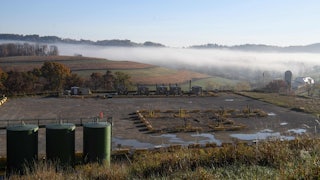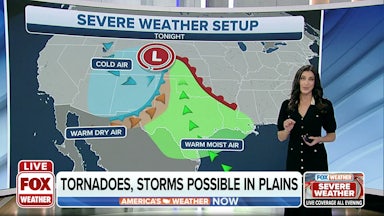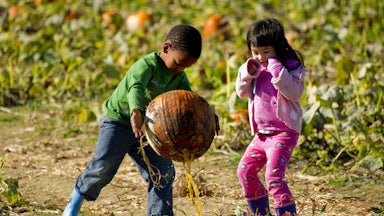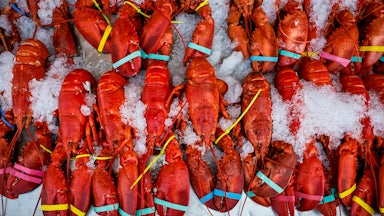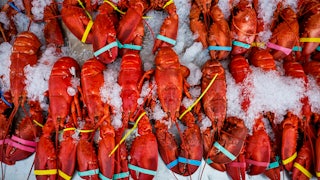Detasseling is a rite of passage for a certain segment of Midwesterners; a baptism by corn. You grab the top of the corn plant, where pollen is produced—the tassel—and pluck it from the rest of the stalk, usually as part of a vast team of workers sweeping through multiple corn fields after a machine has done a first pass. After the first day, the middle-class kids would usually stop showing up. By the end of the season, only a handful of people would remain.
I signed up to detassel for the first time when I was 14, the youngest age at which a minor is legally allowed to work in agriculture outside of school hours, under federal law. I needed a job, but paper routes didn’t really exist anymore, and the profits to be made running a lemonade stand weren’t worth it.
The season started in July, right at the end of summer vacation. Every day at 5:30 a.m., I would walk to a parking lot half a mile away from my house to climb aboard a repurposed school bus. Everyone was given a hat with a mesh lining along the front and was encouraged to wear long sleeves to help shield our arms from the sharp edges of the corn leaves, but I would still return home with a few new scrapes. In the morning, the moisture from the dew would build up along your clothing, sticking to you like a wetsuit. When the sun finally came above the stalks, it would feel like you were boiling alive.
During my second year of detasseling, a heat wave—no doubt exacerbated by climate change—caused the Indianapolis area to reach the hottest recorded temperature for June in almost 60 years. If we were lucky, it would be cloudy for a day or two instead, but if it rained, we would keep working until the supervisor saw lightning. If enough tassels were found in a field we had already detasseled, everyone would have to go back through and recheck their rows.
We worked mostly on foot, especially in the morning. The ground could be too muddy to run a personnel carrier, the large machines with metal baskets on the side that workers could stand in. If you were allergic to pollen, like I am, your lunch break would include a few Benadryl and a Red Bull to combat the drowsiness. We were paid the federal minimum wage of $7.25, but the attrition of workers was so intense that they would offer you a bonus of 25 cents per hour if you never missed a shift.
As a child, I didn’t understand the purpose of the detasseling. None of the full-time adult workers seemed interested in explaining it, beyond the initial pitch given to our parents, and there was certainly no time to stop and ask during the workday. I was taught how to do it and told that it had something to do with pollination, but its purpose was completely alien. Over the years, when someone would ask, “What is detasseling?” I would simply reply, “Hell.” Now, as the planet heats, it’s a hell that’s rapidly getting more erratic.
There are three basic types of corn. The first is sweet, which is what you would find in a can or as an ear at the grocery store—it’s the kind we eat. The second is field, which is processed into livestock feed, high fructose corn syrup, and ethanol. The third is seed, which creates the kernels that farmers will plant for next season’s livestock feed, syrup, and ethanol. Most of the corn in the United States is field corn—around 99 percent—but only seed corn is detasseled.
The point of detasseling is to control the pollination process. If you don’t remove the tassel, the pollen from the tassel will eventually fall onto the silks below, a process called self-pollination. Removing the tassel ensures the plant is pollinated by corn in adjacent rows rather than by itself, creating a hybrid. This makes detasseling one of the only forms of genetic engineering performed by children.
The seeds from these hybrids are then bagged and shipped to farms across the country. Before hybrid seeds became popular, many farmers had simply used the seeds from the best ears in their own fields the year before. But after a drought in the middle of the Great Depression showed that hybrid corn did better under stress than seeds that were open-pollinated, the practice became industry-standard after only a decade. The hybrid plants were sturdier, easier to harvest, and produced more ears. Before hybridization, the average yield always hovered around 25 bushels an acre. According to a forecast by the Agriculture Department, the average yield for 2021 will be 175 bushels per acre.
While seed corn makes up less than 1 percent of the corn grown in the U.S. by acreage, commercial field corn exports rely on these hybrid seeds, making detasseling an essential part of the $75 billion industry. Nebraska Governor Pete Ricketts even declared an official “Detasselers’ Recognition Day” in 2019. Without detasseling, there are no hybrids. Even a small change to the process can have massive unintended consequences for the rest of the industry.
In 2015, two years after I stopped detasseling, Indianapolis experienced one of the wettest summers on record since 1875. The severe rains and flooding that hammered the fields pushed the entire season back, as the soil was too saturated to hold the seeds. Some farmers were forced to wait until early June to begin planting their field corn, two months later than normal. The crops that had already begun to mature started to die: An oversaturation of water in the soil depletes the oxygen supply after only 48 hours. Without it, the shoot is unable to take nutrients from the roots, photosynthesis is inhibited, and the plant becomes more susceptible to rot. The flooding and delays resulted in the destruction of some farms’ entire crops, with more than half a billion dollars lost in corn and soybean production in Indiana alone.
This wasn’t an isolated incident. In 2012, a heat wave with multiple 100-degree days dried out corn crops across the Midwest, which slowed or even halted the pollination process altogether. This year, excessive winds flattened whole fields of corn already weakened by other stressors. In places where the soil was excessively moist, the wind was able to pull the roots out of the ground. A report from researchers at Purdue University predicts that because of climate change, “heat stress and a doubling of water deficits are expected to reduce Indiana corn yields, for current varieties, by 16 to 20 percent by mid-century.”
According to the Purdue report, Indiana has steadily become warmer and wetter. “Mid-century temperatures during Indiana’s growing season, defined as the period from May 1 to Aug. 31, are expected to increase by about 6 to 7°F.” While the higher temperatures will damage crops directly, they will also lead to more extreme weather events.
Alex Ruane, a climate research scientist at NASA and an author on the recent Intergovernmental Panel on Climate Change report, uses computer modeling to predict changes in the agricultural sector by simulating a virtual crop and configuring the physical processes. “Climate change is no longer some future problem,” Ruane told me. “Extreme events in every part of the world are already being influenced by humans.” These local disasters can have ripple effects halfway across the globe. In 2010, Russia completely banned grain exports after droughts and wildfires ravaged its crops, leading to an increase in food prices worldwide. “If you start having more of these extreme events, they are more likely to cross some tipping point where a small impact can become a real disaster.”
There is a clearly defined window for when detasseling should begin. Too early, and the tassel hasn’t sprouted. Too late, and the plant has already self-pollinated. In 2019, an overly wet spring in Indiana—similar to the one in 2015—delayed seed-corn planting dramatically. The detasseling season for many farms was pushed back into August, a month later than usual. With teenagers having to return to school in the fall, farmers began to worry that they wouldn’t have enough workers.
Aside from children, the seed-corn industry also relies on another easily exploitable group: migrant workers. The popularity of detasseling among teenagers has been dropping since the 1980s, as pulling machinery has become more available and has halved the number of people required for crews. Major seed-corn companies, such as those owned by Monsanto and DuPont Pioneer, have used independent contractors to hire both summer vacationers and thousands of migrant farmworkers for decades. These workers, many of whom live in Texas, travel to Indiana and the rest of the corn belt during the detasseling season.
A 2017 investigation by the Midwest Center for Investigative Reporting uncovered allegations of labor violations against Monsanto, DuPont Pioneer, and other seed companies related to their detasseling crews of migrant workers, including heat exhaustion and wage theft. One person in Iowa was allegedly fired by a Monsanto contractor after leaving his assigned row of corn to get water. A year later, in Nebraska, a 52-year-old migrant worker detasseling in 94-degree temperatures was found dead in the middle of a field. In response, the Occupational Safety and Health Administration proposed a penalty of only $11,600.
As the detasseling season gets harder to predict, however, and teenage workers become even scarcer, seed companies may decide to sidestep the process altogether. Detasseling is one of the most expensive steps, and with lower yields on the horizon due to climate change, farms are looking for ways to cut costs. Independent farms, which have already been on the decline, will feel an outsize impact, as only 41 percent of small farmers are able to make a profit each year. One bad detasseling season could easily lead to a noticeably lower quality and amount of field corn for the coming years, which would have enormous knock-on effects in sectors like energy and livestock. In 2013, Monsanto submitted a petition seeking regulatory approval for a genetically engineered corn variety that produces a sterile tassel. The plant would be incapable of self-pollination and would not need to be detasseled at all. This would be a dramatic shift from current practices but a seemingly necessary one as current trends continue.
Thanks to climate change, it is likely that the first job I had a decade ago might not exist in another. Until then, as extreme weather events continue to shift detasseling schedules in unpredictable ways, the work will increasingly be done by migrant workers, while higher temperatures make it even more dangerous.
